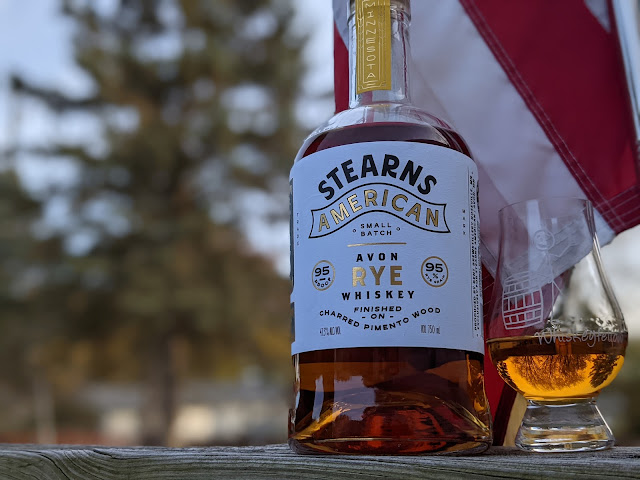Are you familiar with
pimento wood? You may be if you’re a fan of jerk chicken, beef, or pork. You
see, in order for it to be considered “jerk”, it must be cooked over pimento
wood. It is used for barbequing and grows primarily in Jamaica. Pimento wood comes
from an allspice tree, of which the berries make the namesake spice. The wood
is very hard, and, unfortunately, was placed just this year on the
international endangered species list. As such, the only current legal way to
obtain pimento wood is to harvest it from already felled trees. No live cutting
is allowed, and Jamaica is already limiting its export.
Why am I giving you
background on pimento wood? Because I just got done trying Stearns American Avon Rye, which is finished in – you guessed it,
charred pimento wood. I can safely say I’ve never had a whiskey aged or
finished in that before. I’m assuming you probably haven’t, either.
Stearns American begins
with a mash of 95% rye and 5% malted barley. I know what you’re thinking – it
is sourced from MGP. Well, I thought
the same and we’re both wrong, it is sourced but not from them. The newmake is
then aged for 21 months. Currently only available in Minnesota, the suggested
retail for a 750ml package is $49.99, however, I’ve been told by Jeremy Blankenship, the head distiller,
that some retailers are selling it for a buck or so less. He said that he gets
so engrossed in the distilling process and loves hearing his still sing.
“STEARNS AMERICAN stands with free spirited people who live life on their own terms - like the people of central Minnesota who were responsible for the infamous and legendary whiskeys of the 1920's and 30's Prohibition era. The whiskeys were crafted by farmers in barns and cellars across the rural communities to help weather the economic hardships of the times. The call for 'free kittens' on the radio alerted the community to get the next batch of whiskey ready for market.” – Jeremy Blankenship
As I’m getting ready to #DrinkCurious, I’d like to thank
Stearns American for providing me a sample of this Avon Rye in exchange for a
no-strings-attached, honest review.
Appearance: Poured neat in my Glencairn glass, this Rye
was a light, orange-amber. It formed a thin rim that created sticky droplets
that never really went anywhere.
Nose: Dill was easily sniffed out. Beneath that
were allspice, rye, dry oak, something slightly soapy, and a big blast of
clove. As I drew the air into my mouth, dill and clove rolled across my tongue.
Palate: The mouthfeel was oily and thin. The front of
the palate started with caramel and mild peppers (I suppose it could be
pimento, I’ve never had a raw one). The middle offered flavors of dill,
cinnamon, and old leather. On the back, I tasted allspice, oak, rye spice, and
clove.
Finish: The finish was elusive. I don’t mean it
wasn’t there, but initially, I felt it was medium in length. Clove, allspice,
oak, and cinnamon stuck around for a bit, and then everything went away. But,
the leather and mild pepper rose from the ashes and stuck around for several
minutes on my hard palate, reminiscent of jerk.
Bottle, Bar, or Bust: Stearns American Avon Rye was unusual in a
good way. The nose was weird, particularly with that soapy note midway through.
But I’m a fan of clove and that was the strongest clove influence I’ve ever
come across in a nosing. The palate was also unusual in a great way. I enjoy pimentos in olives,
but they’ve also been soaking in brine. I’m guessing some of what I tasted was
raw pimento, but I can’t swear by that. Regardless, for $49.99, this is a heck of an
adventure, and well worth my Bottle
rating. Cheers!
My Simple, Easy to
Understand Rating System
- Bottle = Buy It
- Bar = Try It
- Bust = Leave It
Whiskeyfellow encourages
you to enjoy your whiskey as you see fit but begs you do so responsibly.

Pimento as in pimento wood is different than pimento as in pimento stuffed olive or pimento cheese. The latter is just preserved red pepper and is of Spanish origin.
ReplyDeleteYou correctly has pimento in the Jamaican sense - a native term for the all spice berry and the wood of the tree that grows it.
Thanks for the clarification on that, Eric. I appreciate it. Happy New Year!
DeleteI appreciate your impressions. I was pleasantly surprised by a very unique rye produced locally with a lot of character. Surprisely, it didn’t seem particularly spicy, but it is very much a Rye and very enjoyable. I appreciated your interpretation of the intricacies of its personality, and I have to admit your nose is much better than mine. I had it with supper, but I’ll buy a bottle soon and enjoy “analyzing” it more thoroughly.
DeleteI tried it and LOVED it!!
ReplyDelete